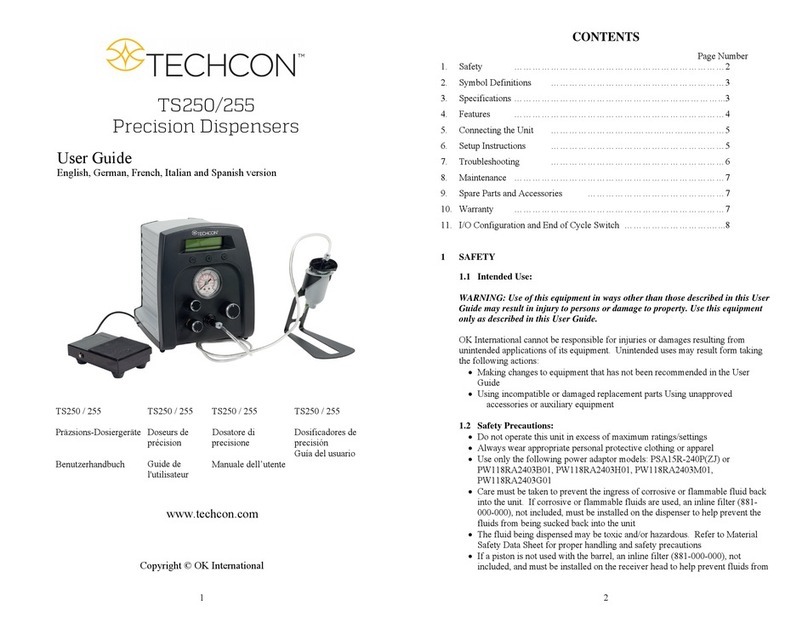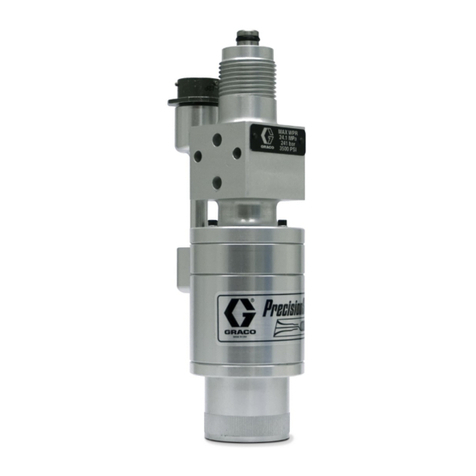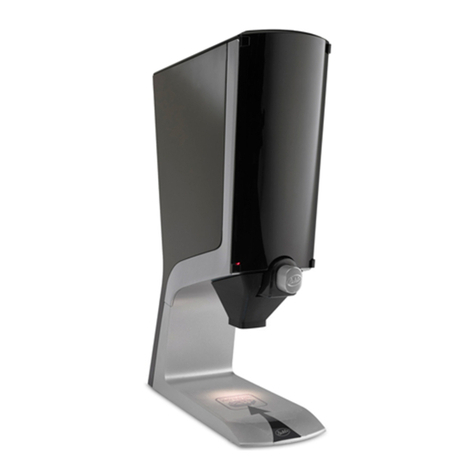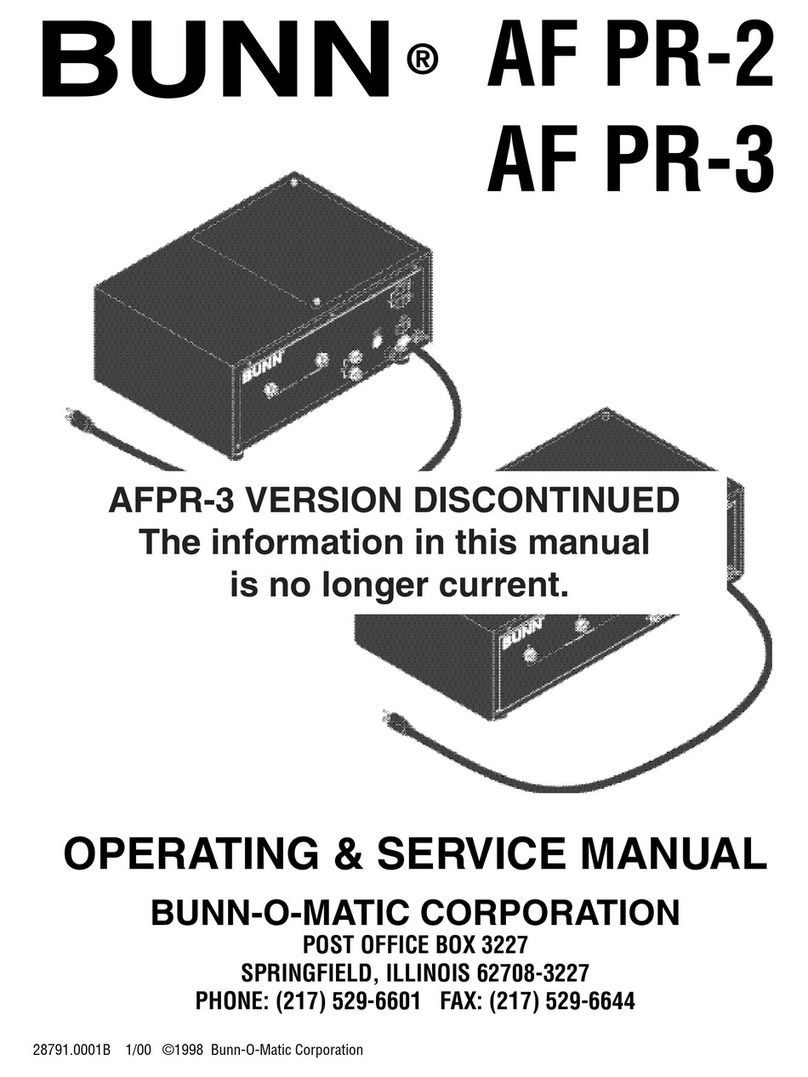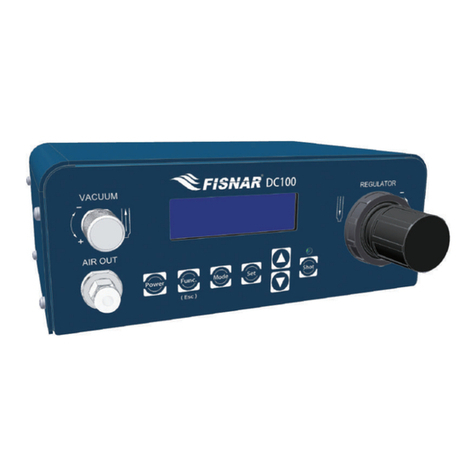TECHCON TS9800 User manual

CONTENTS
Pages
1. SAFETY ………………………………………………………....…….
2. UNPACKING AND INSPECTION ….…………………….……….….
3. TS9800 PIEZO JET VALVE DESCRIPTION……………………………...
4. SETUP INSTRUCTIONS
4.1 Mounting & Connection ………………………………………
4.2 Setup …………………………………………………………..
4.3 Nozzle Calibration …………………………………………….
5. OPERATION
5.1 Start Dispensing ………………………………………………..
5.2 Parameter Settings …………………………………………….
6. HEATING
6.1 Introduction ……………………………………………………
6.2 Safety Instructions ………………………………………………
6.3 Function ………………………………………………………..
6.4 Mounting & Connection ……………………………………….
6.5 Setup ……………………………………………………………
7. VALVE REMOVAL AND CLEANING
7.1 Valve Removal…………………………………………………
7.2 Installation of New Nozzle Insert …....………………………… 2
7.3 Cleaning ……………………………………..…………………
8. TS9800 PIEZO JET VALVE
8.1 Valve Modules …………………………………………………
8.2 Technical Specifications ………………………………………
8.3 Special Features ………………………………………………..
8.4 Materials Applied ………………………………………………
9. TS980 JET VALVE CONTROLLER
9.1 Description …………………………………………………….
9.2 Technical Specifications ……………………………………….
9.3 Features ………………………………………………………..
4-5
6-7
8
9-10
10-13
14-16
17
17-19
20
20
20
21
22-23
24
24-25
25-37
38-39
39
39-40
40
41
41
42
techcon.com/contact-us 2
TS9800 & TS980
Jet Valve Dispensing System User Guide

9.4 Symbol Definitions ……………………………………………
9.5 Operation
9.5.1 Login …………………………………………..……………
9.5.2 Disable Password Protection.……………………………..
9.5.3 Enable Password Protection …………………….…………
9.5.4 Resetting Master Password ……………………..………….
9.5.5 Setup Dispensing Parameters ……………………………
9.5.6 Calling Up Dispense Parameters…………………………….
9.5.7 Reset Cycle Counter ………………………..………………
9.5.8 To Run Dot or Line Mode ……………….…………..…
9.5.9 Service Mode ………………………………….………..…
9.5.10 IoT (Remote Communication) ………………..……..…
9.5.11 Software Update ………………………….……………….
10. SPARE PARTS AND SCHEMATICS
10.1 Tappets & Nozzle Inserts ……………………………………..
10.2 Tools …………………………………………….……………
10.3 Piezo Jet Valve Parts List …………………………….…………….
10.4 DB-15 I/O Port ……….……………………………………….
10.5 Serial Port …………………………………………………….
11. TROUBLESHOOTING
11.1 General Problems…………..…………………………………..
11.2 Key Variables …..…………….….……………………………
11.3 Nozzle Selection ………………………………………………..
11.4 Sample Parameters ……………………………………………..
12. WARRANTY AND RETURN
12.1 Warranty……………………………………………………….
12.2 Return…………………………………………………….…….
43
44
44
45
45-46
46-48
48
49
49-50
50
50-52
52
53
53
54-55
56
46
46
47
57
58
59
59
60-62
63
64
techcon.com/contact-us 3
Jet Valve Dispensing System User Guide
TS9800 & TS980

1. SAFETY
1.1 Intended Use
OK International cannot be responsible for injuries or damages resulting
from unintended applications of its equipment. Unintended uses may result
from taking the following actions:
•Making changes to equipment that has not been recommended in the
User Guide.
•Using incompatible or damaged replacement parts.
•Using unapproved accessories or auxiliary equipment.
1.2 Safety Precautions
•Do not operate this unit in excess of maximum ratings/settings.
•Always wear appropriate personal protective clothing or apparel.
•This equipment is for indoor use only.
1.3 Specified Normal Operation
•The TS9800 System can be used for dispensing fluids with a wide range
of fluid viscosity.
•Additional heating may only be carried out with a heating system from
Techcon.
•The usage of the TS9800 System can be carried out under laboratorial or
production environments.
•Provided the highest frequencies (up to 1500 Hz; average frequency
should not exceed 800 Hz) and parameter settings must be followed.
•The usage of media which affects the functioning of the TS9800 System
must be avoided.
1.4 Technical Details
•The usage of the TS9800 System is only allowed inside and up to 2,000
meters above sea level.
•Relative humidity: maximum 80% at 31 °C, decreasing linear until 50%
at 50 °C.
•Fluctuation of the line voltage is not allowed over ± 10% of the nominal
voltage.
•Transient over voltage according to IEC 60364-4-443 will be tolerated:
degree of pollution 2 is allowed.
•The employed power cords must be accompanied by an earthing
equipment conductor. The used power sockets must be within safety
regulations. When using cables which are not supplied by OK
International, the warranty of the TS9800 System will only range till the
operator interface.
•During installation and operation, please be sure to supply enough air
circulation: minimum distance above and below the system (valve and
control unit) are 1.5 cm. OK International advises a separate housing
which is in alignment of fire prevention covering EN 61010-1.
techcon.com/contact-us 4
Jet Valve Dispensing System User Guide
TS9800 & TS980

•When using the TS9800 Piezo Jet Valve with heater, please note that the
tangible surfaces can be hot, which can lead to severe burns.
•The safety by the apparatus can be affected by using parts/units not
advised by OK International. The same can be considered for the usage
of dangerous substances or operation in an explosive environment, for
which the TS9800 System is not designed.
1.5 Warning Notices
•Never use the valve without the nozzle insert or without fluid.
•Never disconnect the cables during the dispensing process.
•Avoid fast turning on and off of the control unit.
•Avoid long stand-by durations while the system is switched on.
•The TS9800 System is constructed modularly. If a defect occurs, the
effected module should not be interchanged with other parts. The whole
system needs to be sent back to Techcon for repair. The cables can stay
with the customer but need to be checked. Information on how to check
the performance is available from Techcon.
•Avoid hard placing of the valve on the working surfaces during
mounting and dismounting.
•Store the valve on a flat surface during the cleaning procedures. Do not
shake or bang the valve on any hard surface.
•For cleaning the valve, use a damp (isopropanol) cloth and make sure
that no fluid leaks into the valve (e. g. via connectors).
•Never connect the TS9800 Piezo Jet Valve to a control unit other than
the TS980 (connecting it to another control system will damage the
valve).
•Check whether all fluid connections are attached and sealed.
•Make sure all fluid contacting parts are stable against the fluid.
•Make sure all electronic connections are connected and interlocked.
•Make sure the supply pressure does not exceed the admissible range.
•Make sure the maximum possible system pressure ranges between the
valve limit and the connection supplies limit - in no case above it.
•Check before the use of a heating device that the fluid does not tend
toward unwanted reactions at elevated temperatures.
•When using a heating device, make sure the set temperature does not
exceed the recommended temperature of the material (consult with the
material manufacture).
•When using a heating device, please pay attention to the
syringe/cartridge feeding pressure.
•The heating of the TS9800 System cannot exceed 90°C.
•Caution: The TS9800 Piezo Jet Valve works with the normally open
concept. Therefore, without supply voltage, the valve will open, and the
fluid may leak. To avoid leakage, disconnect the air supply to the fluid
syringe before shutting down the control unit.
techcon.com/contact-us 5
Jet Valve Dispensing System User Guide
TS9800 & TS980

2. UNPACKING AND INSPECTION
Carefully unpack the valve and examine the items contained in the carton.
Piezo Jet Valve Package Includes:
1) TS9800 Piezo Jet Valve
2) Syringe Bracket with M4 holding screw
3) Nozzle installation tool
4) Nozzle adjustment tool
5) Tappet changing tool
6) Tappet seal tool
7) Heater Cable, 2M (4-pin connectors) *Available only if the piezo jet
valve with heating system was ordered
8) Heat Guard Kit with M6 holding screw *Available only if the piezo jet
valve with heating system was ordered
9) User Guide (not pictured)
*Heater and Nozzle Insert are sold separately
Inspect the unit for any damage which may have occurred in transit. If such
damage has occurred, notify the carrier at once. Claims for damage must be
made by the consignee to the carrier and should be reported to the
manufacturer.
Figure 1A: TS9800 Piezo Jet Valve
techcon.com/contact-us 6
Jet Valve Dispensing System User Guide
TS9800 & TS980

Controller Package Includes (sold separately):
1) Jet Valve Smart Controller TS980
2) Sensor Cable, 2M (6-to-5 pin connectors)
3) Actuator Cable, 2M (3-to-2 pin connectors)
4) Power Supply (not pictured)
Figure 1B: TS980 Smart Controller
techcon.com/contact-us 7
Jet Valve Dispensing System User Guide
TS9800 & TS980

3. TS9800 PIEZO JET VALVE DESCRIPTION
The TS9800 Series Piezo Jet Valve is a piezoelectric driven, non-contact
dispensing valve capable of handling fluid at different viscosities. Piezo Jet
Valve offers a fast-jetting action producing hundreds of accurate deposits in
less than one second.
Every component of the valve was designed to the highest tolerances and
manufactured to the strictest degree of precision, ensuring world class
accuracy and repeatability in drop-to-drop dispensing volume.
Piezo Jet Valve’s compact size and modular design aids integration into
robotic systems. The valve features fully adjustable parameter settings,
allowing the operator to change the jetting properties for different fluid types
and optimize the process for repeatable dispensing.
A variety of nozzle shapes and sizes, along with different tappet
configurations, provides a wide spectrum of output jet deposits.
techcon.com/contact-us 8
Jet Valve Dispensing System User Guide
TS9800 & TS980

4. SET UP INSTRUCTIONS
4.1 Mounting & Connection
The TS9800 Series Piezo Jet Valve should be used on an automated XYZ
table. It is very important that the valve is mounted on the Z-axis gantry, in
a secure manner, that will not allow loosening during dispense operation.
Mount the valve to the XYZ table bracket through the two tap holes (M4).
To prevent rust, it is recommended the bracket be made of stainless steel,
galvanized steel, or non-ferrous metals. The screwing depth is about 6 mm.
The connection of the TS9800 Piezo Jet Valve to the TS980 Smart
Controller is done via the 3-pin plug and the 6-pin plug on the top of the
valve. The plugs are protected against mix-up by having different
number of pins. After connecting, the plug must be locked in place by
turning the locking nut on the cable’s mating connector a quarter of a
turn in a clockwise direction.
The 3-pin cable supplies the power for the piezo stack from 0 VDC to
100 VDC (bipolar operation). The 6-pin cable transfers the data of the
integrated sensor inside the valve. Disconnection is done by first rotating
the locking nut on the cable’s mating connector a quarter of a turn in a
counterclockwise direction, then gently pulling the connector axially
backwards. Caution:Never disconnect the cables from the valve while
the system is still dispensing, this will lead to damage to the valve and
the control unit. If the system is not operating, you can disconnect the
valve and the control unit.
Figure 2: Mounting
Mount the bracket to the two sets of
mounting holes:
2x thread M4
Thread depth: 6 mm
Distance to center: 45 mm
2x ø4mm dowel pin holes
Hole depth: 6mm
Distance to center: 31 mm
techcon.com/contact-us 9
Jet Valve Dispensing System User Guide
TS9800 & TS980

4.2 Setup
WARNING: Before starting the Jet Valve System, carefully read through
this User Guide and pay attention to the Warning and Caution notices.
Note: Complete disassembly and maintenance instructions can be found
in Section 7.
Figure 3: Connection
techcon.com/contact-us 10
Jet Valve Dispensing System User Guide
TS9800 & TS980

Step 1:
•Use the provided nozzle
adjustment tool (1) to
remove the nozzle
adjustment nut/bushing
assembly (2) and protective
nylon washer (3).
Step 2:
•Use the provided nozzle
installation tool (4) to
remove the nozzle bushing
(5) from the nozzle
adjustment nut (6).
Step 3:
•Press the nozzle insert (7) into
the nozzle bushing with the
smaller end facing outward.
Caution:To sit correctly, the
nozzle insert must snap in
lightly. Make sure it sits level
within the socket.
•Place the bushing/nozzle insert
assembly on the nozzle
installation tool in the vertical
position to prevent the nozzle
insert from dropping out.
Step 4:
•Slowly screw the nozzle
adjustment nut into the
bushing/nozzle insert assembly.
Caution:Continue to hold the
assembly in the vertical position
while hand-tightening the
nozzle adjustment nut.
techcon.com/contact-us 11
Jet Valve Dispensing System User Guide
TS9800 & TS980

Step 5:
•Use the nozzle adjustment tool
to securely tighten the
assembly.
Step 6:
•Screw the nozzle unit (nozzle
bushing, nozzle insert and
adjustment nut) to the fluid
manifold by hand (or use the
nozzle adjustment tool) for
about 3-4 turns only.
Step 8:
•Mount the syringe bracket (8) by
placing it on the side of the
valve, then use the 2.5 mm hex
wrench to install the provided
M4 screw (9) to the tapped hole
and secure the bracket in place.
•Insert the material syringe
through the bracket. Connect the
syringe to the valve’s luer-lock
fitting (10). Caution: When
removing the syringe, use 8 mm
open-jaw hex wrench to hold the
fitting tight to prevent it coming
loose from the fluid box adapter.
•Mount the valve in the vertical
position on a test stand or robot.
Step 7:
•To prevent fluid leakage during
dispensing, make sure the fluid
box adapter is tightened to the
fluid manifold. Use the nozzle
adjustment tool to tighten the
locking screw.
techcon.com/contact-us 12
Jet Valve Dispensing System User Guide
TS9800 & TS980

Step 11:
•The setup is now complete.
Proceed to next section 4.3 to
perform the nozzle calibration
process.
Step 9:
•Connect the valve cables to the
controller. Sensor cable (6-to-5
pins) to the ‘SENSOR’port
(11); Actuator cable (3-to-2
pins) to the ‘ACTUATOR’
port (12). Caution:After
connecting, tighten the locking
sleeve to secure the
connection.
•Connect the provided external
power supply to the ‘DC-IN’
port (13).
Step 10:
•Connect the first ø4mm OD air
tubing from the air pressure
source to the ‘IN’port (14).
Caution:This air source must
be regulated and filtered
(dry) separated from the air
pressure source for the material
syringe or reservoir.
•Connect the second ø4mm OD
air tubing from the ‘OUT’port
(15) to the air fitting on top of
the Jet Valve (16).
•Turn up the air pressure for
cooling to the maximum of 10
psi.
techcon.com/contact-us 13
Jet Valve Dispensing System User Guide
TS9800 & TS980

4.3 Nozzle Calibration
The purpose of the nozzle calibration process is to make sure the nozzle
insert is installed at the correct position with respect to the tappet to prevent
leakage and to ensure proper dispensing.
Follow the instructions below before starting the actual dispense procedure.
WARNING:
•Make sure the nozzle unit is loose before turning the controller
on.
•For proper calibration and operation, the jet valve must be
securely mounted on a test stand or robot in the vertical position.
Do not calibrate or operate the valve while it is placed insecurely
on bench top.
1. Turn on the controller by pressing the On/Off switch.
2. Touch the ‘Login’icon to enter the login screen.
3. Enter the default password ‘0000”in the password window. Then touch the
‘Accept’icon to save and exit. Attention: For changing the password,
refer to section 9.5.1.
4. Make sure the valve is in the closed position. The ‘Close’icon is shown on
the home screen.
techcon.com/contact-us 14
Jet Valve Dispensing System User Guide
TS9800 & TS980

5. Start the calibration process by touching the ‘Calibration’icon.
Caution: For maximum calibration accuracy, do the following:
•Disconnect air or fluid pressure to the fluid inlet before starting
the calibration process.
•If the fluid manifold with heater is being used, turn the heater on
and allow the fluid manifold to warm up to the desired operating
temperature, then turn off the heater before starting the calibration
process (refer to Section 6 for more details on how to operate the
heating system).
6. Use your fingers to tighten the nozzle unit into the fluid manifold until it
comes to a complete stop against the tappet.
Caution: Do not over-tighten the nozzle unit.
7. Touch the “Start”icon to begin the calibration process.
8. The system will warm up and the calibration waveform will start right after
warm-up shots.
techcon.com/contact-us 15
Jet Valve Dispensing System User Guide
TS9800 & TS980

9. The system will take about 15 –20 seconds for warming up and starting up
the computation. During this time, the front panel calibration LED is off.
10. When the system completed the initial computation, the LED light will turn
Orange.
11. Quickly loosen the nozzle unit by about quarter of a turn until the LED light
turns Red.
12. Slowly tighten the nozzle unit to the calibrated position until the LED light
turns Green.
Caution: Once the proper calibration condition is achieved, immediately go
to step 12.
13. The calibration process is now completed. Touch the ‘Accept’icon to save
and exit.
The valve is now ready for dispensing application.
Remarks:
•You can leave the calibration procedure by touching the ‘Accept’
icon.
•The calibration procedure should be done in a cleaned, dry
system to avoid any influences of the material between nozzle
insert and tappet and to get a consistent dispense result.
•If the fluid contains particles (fillers), the calibration procedure
performed with fluid is not possible. It must be performed
without fluid.
techcon.com/contact-us 16
Jet Valve Dispensing System User Guide
TS9800 & TS980

5. OPERATION
5.1 Start Dispensing
The valve is now ready to dispense. Dispensing fluid (via cartridge/syringe
or reservoir) must be connected to the air pressure regulator.
Enter the desired dispensing parameters found in section 7.5.5 (Rising,
Open Time, Falling, Delay, Needle Lift, and Number of Pulses), then touch
the ‘Save’icon. Information to the values can be found in the table for
‘essential parameters’on the next page.
To start the dispensing, touch the ‘Run’icon or use external start
signal for both or dot mode. When in line mode,
‘Run’can only be activated or triggered by an external device.
Attention: Use the Purge feature to de-air (removal of air in the system)
after going through the calibration procedure in section 4.3 (e. g. after the
change of cartridge/syringe and/or after the removal of nozzle). To purge,
touch and hold the ‘Purge’ icon and it will run the parameters in the
current program until the purge icon is released.
5.2 Parameter Settings for the Dispensing Process
The TS9800 Piezo Jet Valve System works according to the control profile
shown below:
both
Figure 4: Control Curve
Delay
Open time
Rise
Fall
One Full Cycle
(Frequency)
techcon.com/contact-us 17
Jet Valve Dispensing System User Guide
TS9800 & TS980

Essential Parameters:
FUNCTION
WHAT & WHY
SUGGESTION
RISE
Time to lift the tappet
from fully closed to
opened positions
Minimum setting is 80 µs
Maximum setting is 1999 µs
Depending on fluid viscosity, start at about 300 µs
Rise time can also affect the accumulation or satellite
OPEN
Time to allow material to
fill the cavity and to jet
out
For low viscosity material, open time can be set between 1-
300 µs
For medium viscosity material, open time can be set between
200 - 1000 µs
For high viscosity material, open time can be set between 500
- 2500 µs
Smaller shot requires smaller open time
Bigger shot requires larger open time
Minimize the open time to keep the shot as clean as possible
FALL
Time to jet out the
material
Minimum setting is 80 µs (smaller the value produces
stronger the punch/jetting)
Maximum setting is 1999 µs (larger the value produces
slower the punch/jetting)
Higher viscosity material requires stronger punch setting
Fall time can also affect the accumulation or satellite
Slow down the fall time to reduce satellite
Increase the fall to reduce accumulation
DELAY
Time between pulses
More important in Line Mode
Important in Dot Mode if there are multiple pulses in one dot
(number of pulses in a certain time)
Delay time in single pulse/shot jetting is not important since
the robot movement will take longer
Shorter delay time produces closer dots as it tries to connect
the dots to form the line
Longer delay time produces dots which are further apart
LIFT
Percentage the tapper lifts
from fully closed to
opened positions
Higher lift produces stronger punch/jetting
The valve is more stable with lift higher than 40%
Higher lift produces more volume
Lower lift produces less volume
Higher lift and shorter fall time may be necessary for
dispensing high viscosity material or stringy material.
Activating heater may also help to reduce the lift percentage
and fall time
PULSE
Number of shots
In Dot Mode, it can be set from 1 to 9999999 pulses
In Line Mode, it defaults to pre-set value
One dot can be an accumulation of multiple pulses (e.g. one
dot can be 1 pulse or 20 pulses)
Multiple pulses can be set to increase dot size or use a larger
diameter nozzle
HEATER
Heater inside the fluid
manifold
Help to stabilize the process
Help to lower the material viscosity for better flow
Help to reduce the stringiness of a material for better jetting
Warning: Consult with the material manufacturer to prevent
over-heating of material. Techcon will not be responsible for
damages caused by hardened material inside the fluid
manifold and/or nozzle
Table 1 –Essential Parameters
techcon.com/contact-us 18
Jet Valve Dispensing System User Guide
TS9800 & TS980

After entering the dispensing parameters, touch the ‘Save’icon to save all
the parameters to the current program location. You can then start your
dispensing process. Note: For more detail on how to enter the dispensing
parameters, refer to section 9.5.3.
techcon.com/contact-us 19
Jet Valve Dispensing System User Guide
TS9800 & TS980

6. HEATING
6.1 Introduction
The TS9800 Piezo Jet Valve with heating system is available for heating
high viscosity fluid.
The heating system also helps to maintain constant temperature. Required
parts:
•TS9800 Piezo Jet Valve with heater
•Heater Cable
•Heat Guard Kit
6.2 Safety Instructions
•Use of the Piezo Jet Valve with heating system should only be done
by trained staff.
•Carefully review the material safety data from the dispensing
material.
•Wear adequate protective clothing before starting to dispense
aggressive fluid.
•Be cautious that the media you want to dispense is applicable for
use with a heating system.
Caution:
•When using the Piezo Jet Valve with heater, please consult with
the material manufacture for proper operating temperature.
•Be aware of the exposed surface and fittings on the manifold.Do
not touch the heater without protective wear. Failure to do so can
result in serious burns and/or injuries.
6.3 Function
Resistance
All hydrous solvents (Media,
organic acid, and base)
Maximum heater setting value
90°C
Supply Voltage
24 VDC
Power consumption
40 W
techcon.com/contact-us 20
Jet Valve Dispensing System User Guide
TS9800 & TS980
This manual suits for next models
1
Table of contents
Other TECHCON Dispenser manuals
Popular Dispenser manuals by other brands
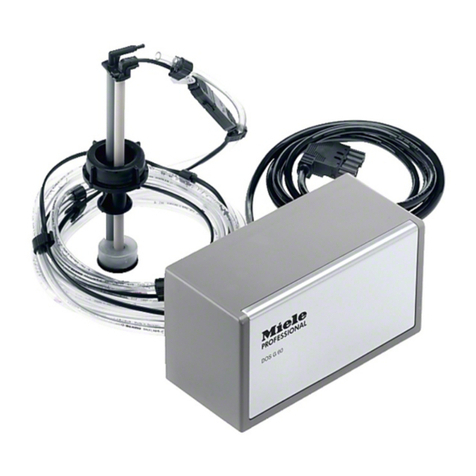
Miele professional
Miele professional DOS-Modul G 60 Fitting instructions
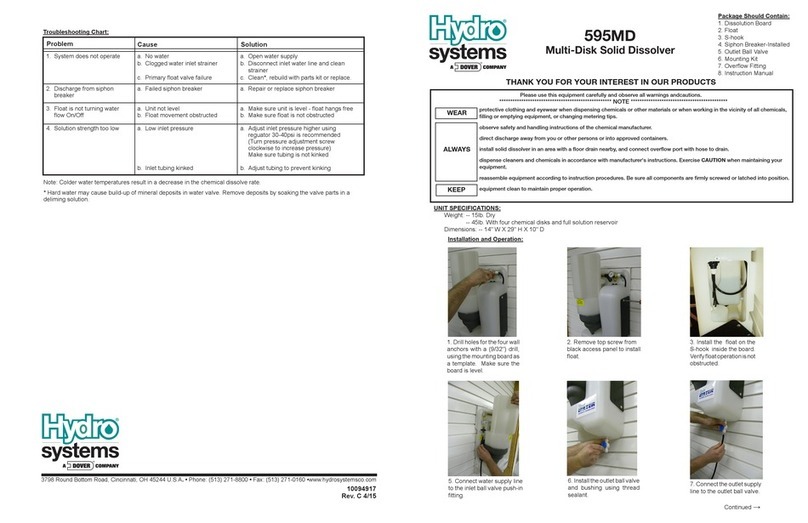
Dover
Dover Hydro systems 595MD quick start guide
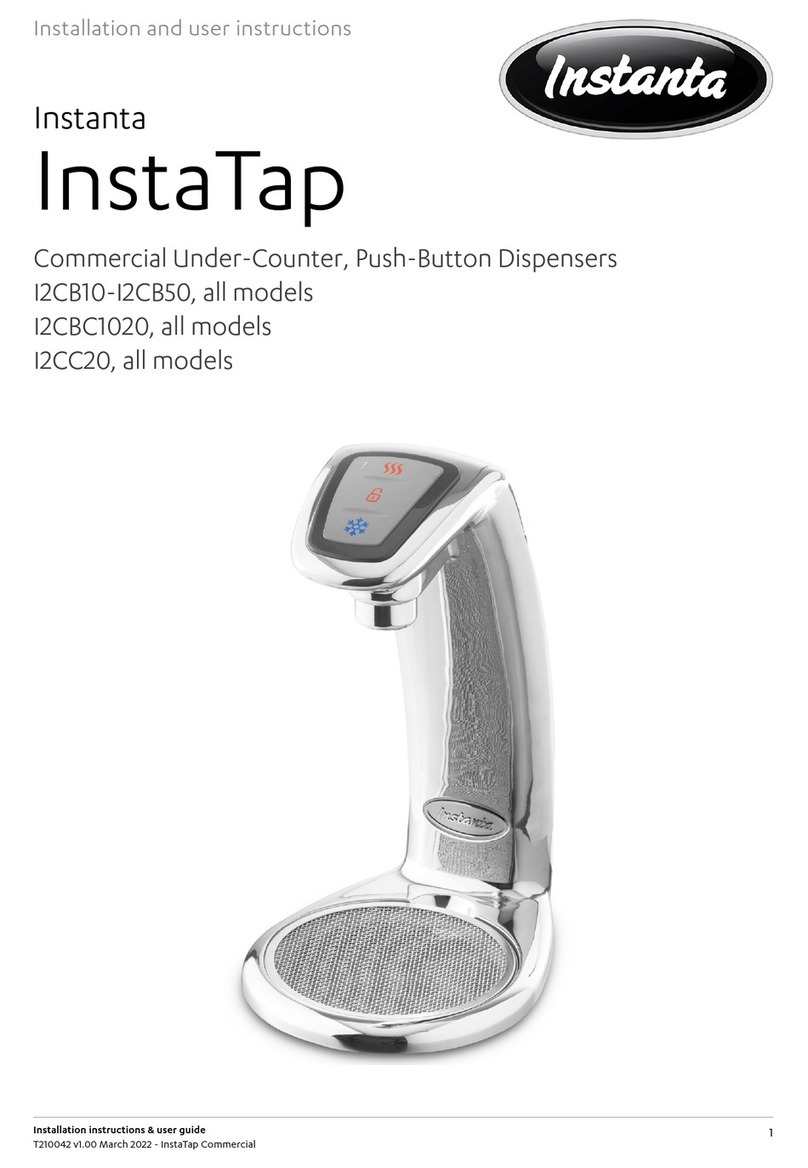
Instanta
Instanta InstaTap I2CB10 Installation and user instructions

Curtis
Curtis TCT Service manual
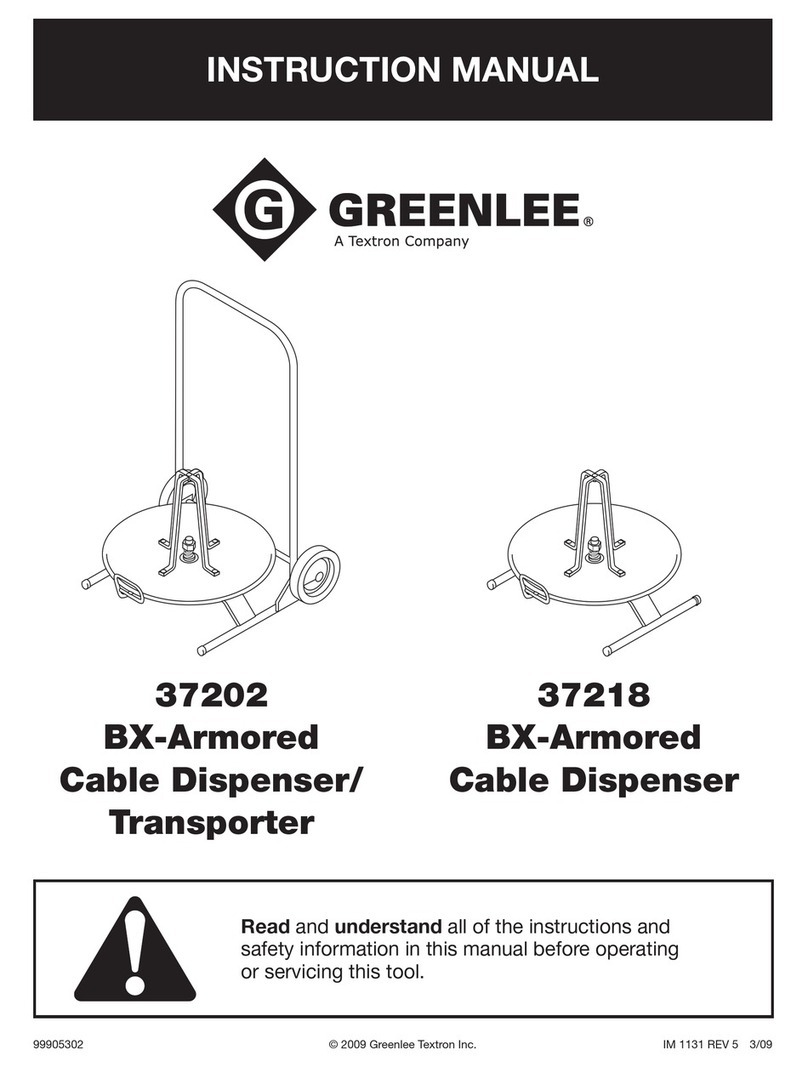
Textron
Textron Greenlee 37218 instruction manual
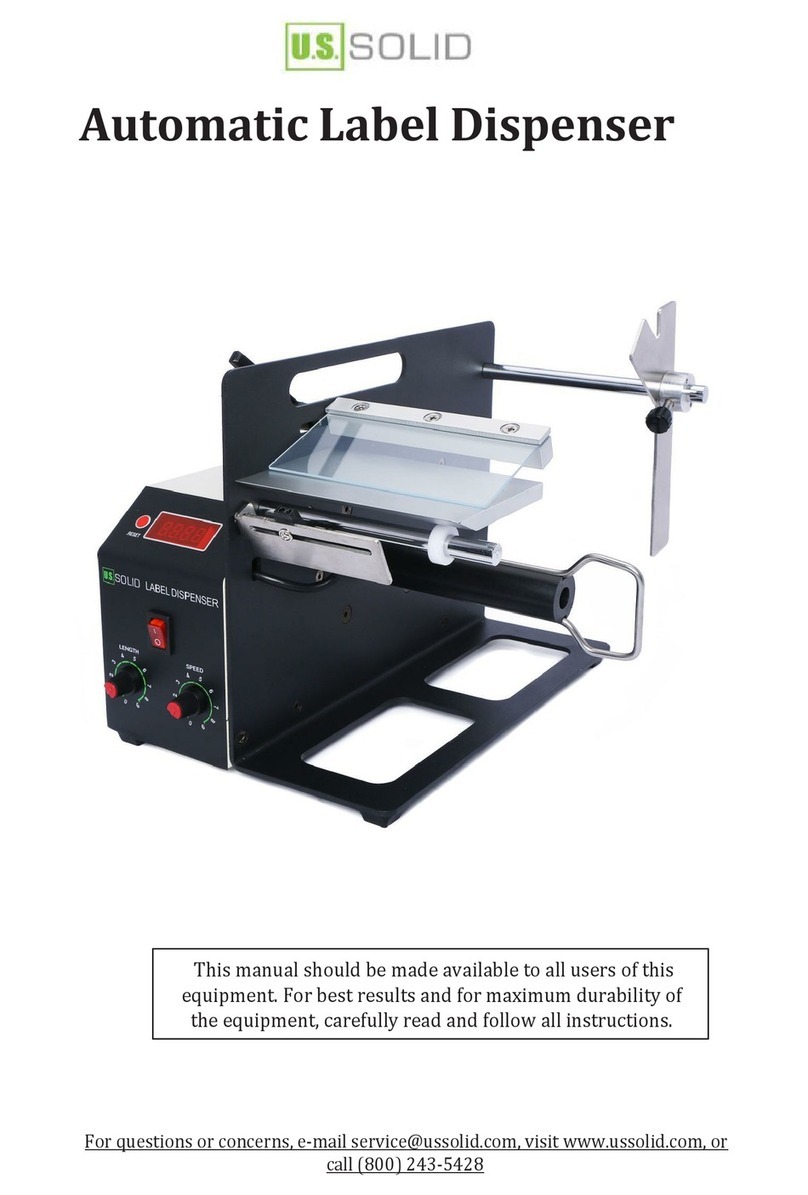
U.S. Solid
U.S. Solid USS-LD00014-120MM quick start guide
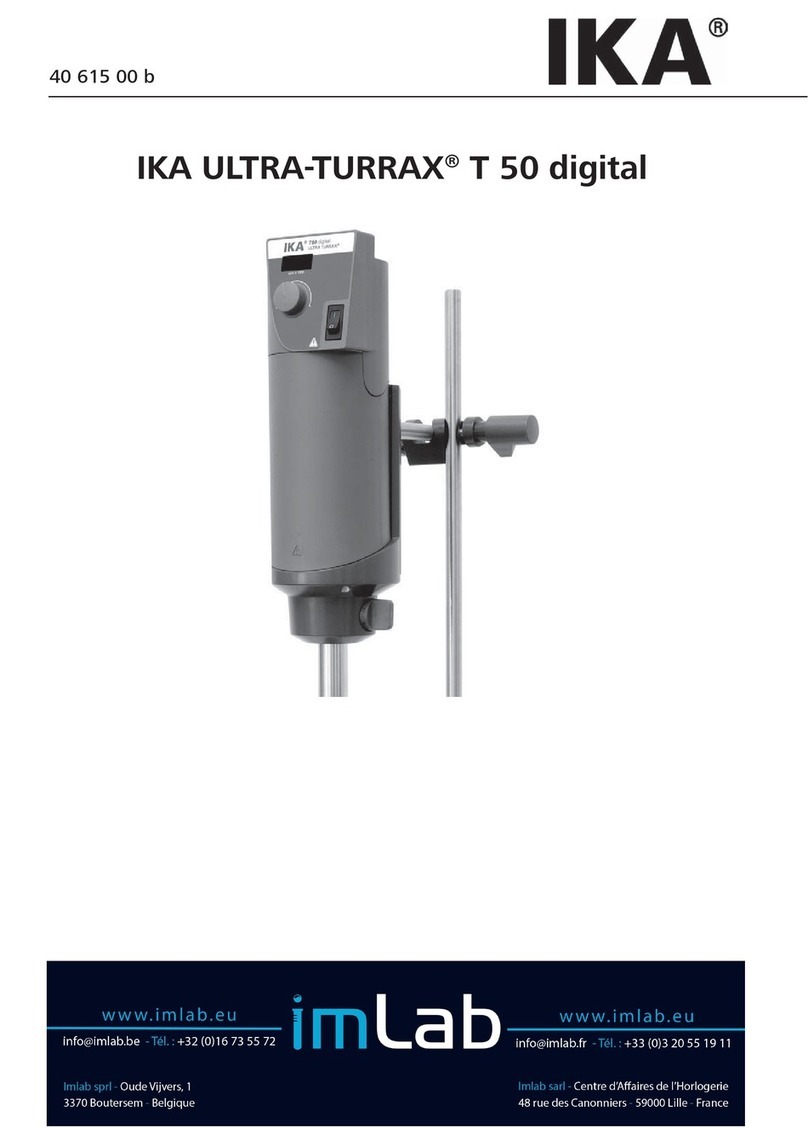
IKA
IKA ULTRA-TURRAX T50 basic manual

Scotsman
Scotsman iceValet HD22 Specification sheet
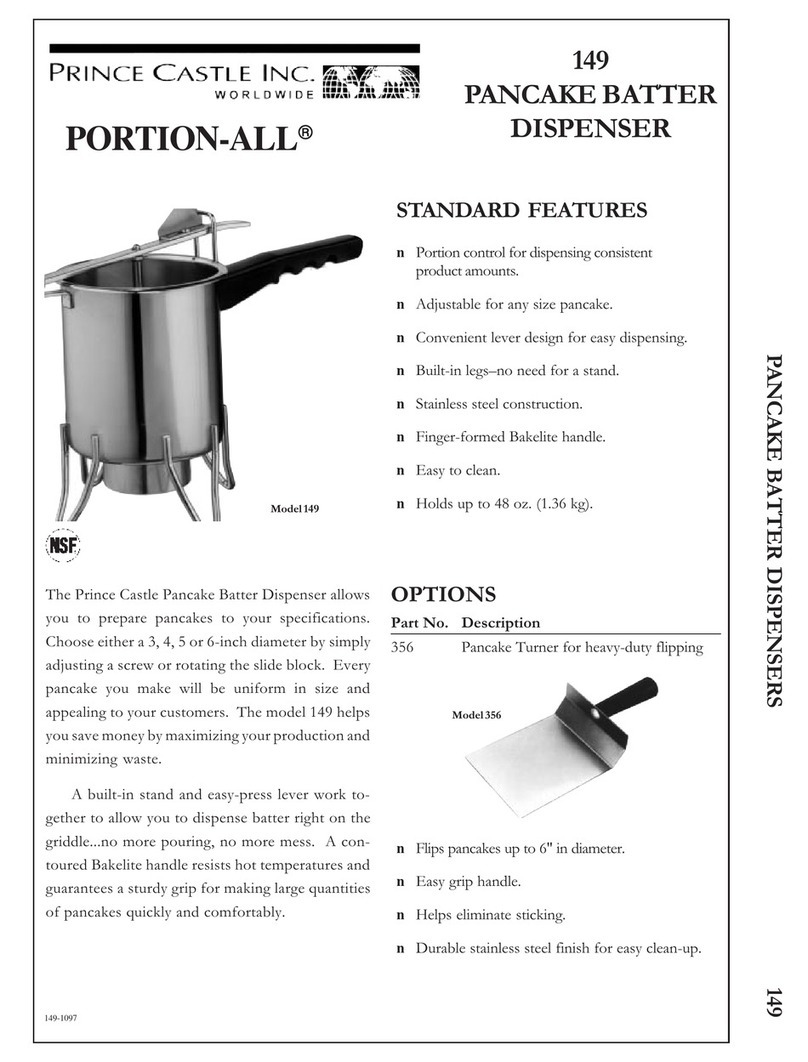
Prince Castle
Prince Castle PANCAKE BATTER DISPENSER 149 Specifications
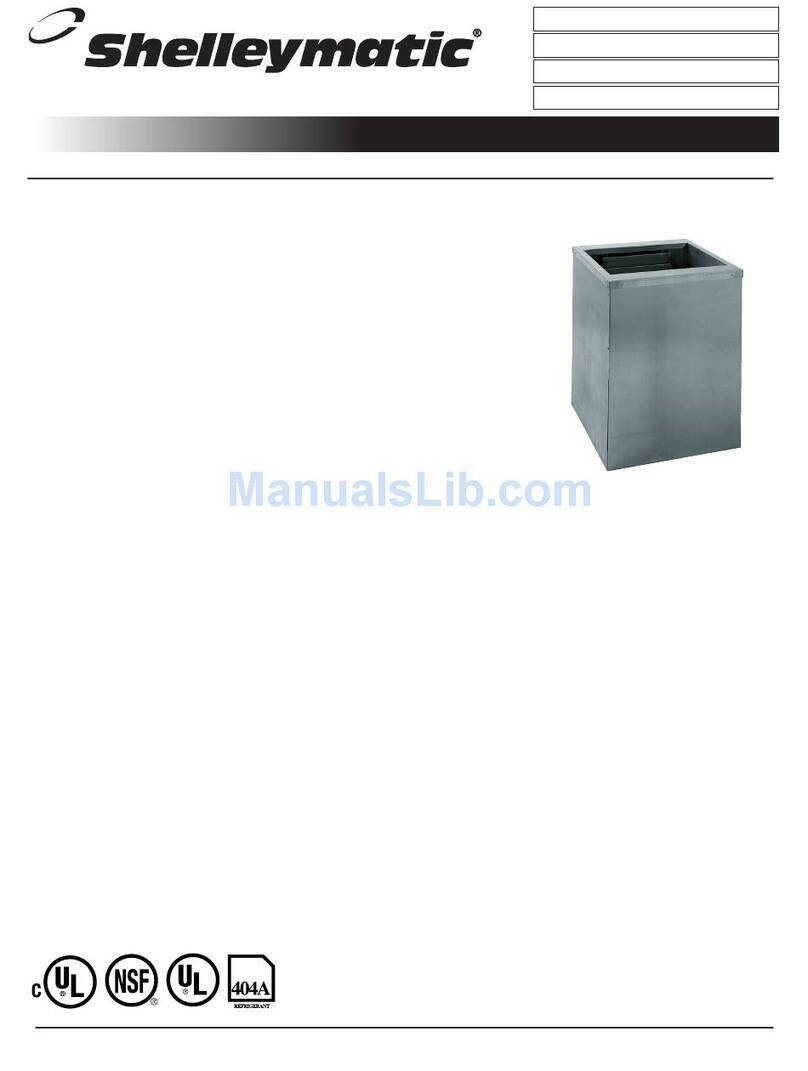
Delfield
Delfield Shelleymatic T-1221H Specifications
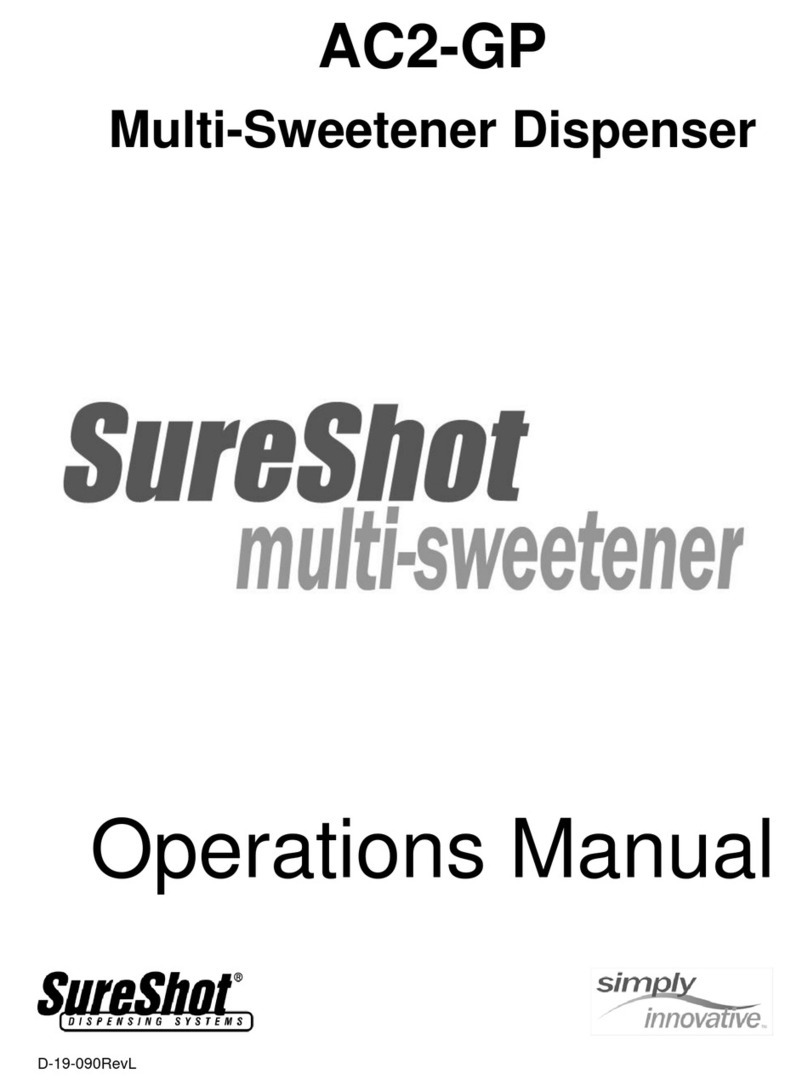
Sureshot Dispensing Systems
Sureshot Dispensing Systems AC2-GP Operation manual
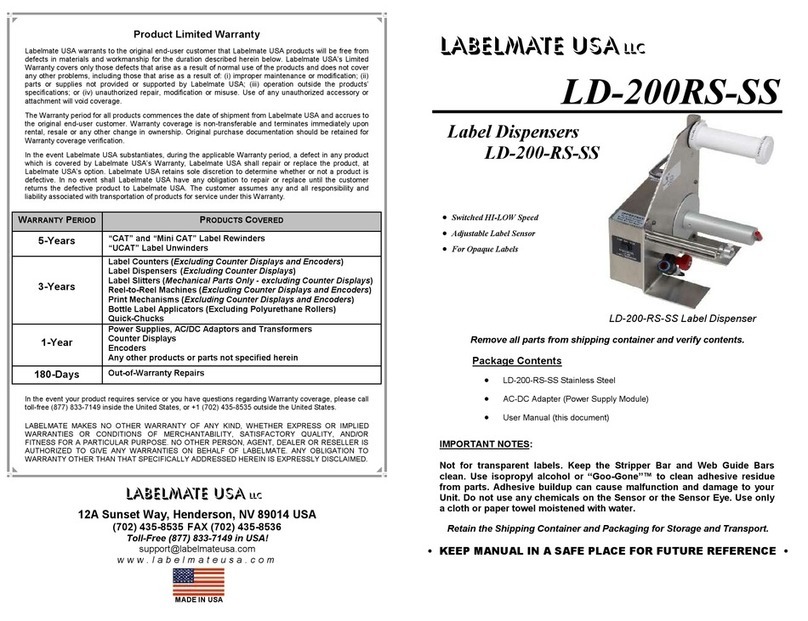
Labelmate
Labelmate LD-200-RS-SS quick start guide

